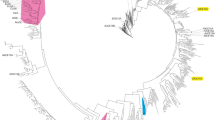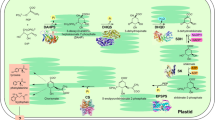Abstract
Deoxysugar, 2′, 3′, 4′-tri-O-methylrhamnose is an essential structural component of spinosyn A and D, which are the active ingredients of the commercial insect control agent, Spinosad. The spnH gene, which was previously assigned as a rhamnose O-methyltransferase based on gene sequence homology, was cloned from the wild-type Saccharopolyspora spinosa and from a spinosyn K-producing mutant that was defective in the 4′-O-methylation of 2′, 3′-tri-O-methylrhamnose. DNA sequencing confirmed a mutation resulting in an amino acid substitution of G-165 to A-165 in the rhamnosyl 4′-O-methyltransferase of the mutant strain, and the subsequent sequence analysis showed that the mutation occurred in a highly conserved region of the translated amino acid sequence. Both spnH and the gene defective in 4′-O-methylation activity (spnH165A) were expressed heterologously in E. coli and were then purified to homogeneity using a His-tag affinity column. Substrate bioconversion studies showed that the enzyme encoded by spnH, but not spnH165A, could utilize spinosyn K as a substrate. When the wild-type spnH gene was transformed into the spinosyn K-producing mutant, spinosyn A production was restored. These results establish that the enzyme encoded by the spnH gene in wild-type S. spinosa is a rhamnosyl 4′-O-methyltransferase that is responsible for the final rhamnosyl methylation step in the biosynthesis of spinosyn A.




Similar content being viewed by others
References
Bate N, Cundliffe E (1999) The mycinose-biosynthetic genes of Streptomyces fradiae, producer of tylosin. J Ind Microbiol Biotechnol 23:118–122. doi:10.1038/sj.jim.2900707
Fouces R, Mellado E, Diez B, Barredo JL (1999) The tylosin biosynthetic cluster from Streptomyces fradiae: genetic organization of the left region. Microbiology 145:855–868
Inouye M, Suzuki H, Takada Y, Muto N, Horinouchi S, Beppu T (1994) A gene encoding mycinamicin III O-methyltransferase from Micromonospora griseorubida. Gene 141:121–124
Aguirrezabalaga I, Olano C, Allende N, Rodriguez L, Brana AF, Mendez C, Salas JA (2000) Identification and expression of genes involved in biosynthesis of L-oleandrose and its intermediate L-olivose in the oleandomycin producer Streptomyces antibioticus. Antimicrob Agents Chemother 44:1266–1275. doi:10.1128/AAC.44.5.1266-1275.2000
Paulus TJ, Tuan JS, Luebke VE, Maine GT, Dewitt JP, Katz L (1990) Mutation and cloning of eryG, the structural gene for erythomycin O-methyltransferase from Saccharopolyspora erythraea, and expression of eryG in Escherichia coli. J Bacteriol 172:2541–2546
Ikeda H, Wang LR, Ohta T, Inokoshi J, Omura S (1998) Cloning of the gene encoding avermectin B 5-O-methyltransferase in avermectin-producing Streptomyces avermitilis. Gene 206:175–180. doi:10.1016/S0378-1119(97)00581-7
Patallo EP, Blanco G, Fischer C, Brana AF, Rohr J, Mendez C, Salas JA (2001) Deoxysugar methylation during biosynthesis of the antitumor polyketide elloramycin by Streptomyces olivaceus. J Biol Chem 276:18765–18774. doi:10.1074/jbc.M101225200
Kirst HA, Michel KH, Martin JW, Creemer LC, Chio EH, Yao RC, Nakatsukasa WM, Boeck LD, Occolowitz JL, Paschal JW, Deeter JB, Jones ND, Thompson GD (1991) A84543-A, Unique fermentation-derived tetracyclic macrolides. Tetrahedron Lett 32:4839–4842
Sparks TC, Crouse GD, Drust G (2001) Natural products as insecticides: the biology, biochemistry and quantitative structure-activity relationships of spinosyns and spinosoids. Pest Manag Sci 57:896–905. doi:10.1002/ps.358
Waldron C, Matsushima P, Rosteck PRJ, Mbroughton MC, Turner J, Madduri K, Crawford KP, Merlo DJ, Baltz RH (2001) Cloning and analysis of the spinosad biosynthetic gene cluster of Saccharopolyspora spinosa. Chem Biol 8:487–499. doi:10.1016/S1074-5521(01)00029-1
Madduri K, Waldron C, Merlo DJ (2001) Rhamnose biosynthesis pathway supplies precursors for primary and secondary metabolism in Saccharopolyspora spinosa. J Bacteriol 183:5632–5638. doi:10.1128/JB.183.19.5632-5638.2001
Zhao Z, Hong L, Liu HW (2005) Characterization of protein encoded by spnR from the spinosyn gene cluster of Saccharopolyspora spinosa: mechanistic implications for forosamine biosynthesis. J Am Chem Soc 127:7692–7693
Tietze LF, Brasche Staddler GC, Grube A, Bohnke AN (2006) Multiple palladium-catalyzed reactions for the synthesis of analogues of the highly potent insecticides spinosyn A. Angew Chem Int Ed 45:5015–5018. doi:10.1002/anie.200601003
Kirst HA, Michel KH, Mynderse JS, Chio EH, Yao RC, Nakatsukasa WM, Boeck LD, Occolowitz LJ, Paschal JW, Deeter JB, Thompson GD (1992) Discovery, isolation, and structure elucidation of a family of structurally unique, fermentation-derived tetracyclic macrolides. In: Maker DR, Fenys JG, Steffens JJ (eds) Synthesis and chemistry of agrochemicals III. Amercian Chemical Society, Washington, DC, pp 214–225
Hahn DR, Balcer JL, Lewer P, Gilbert JR, Graupner P (2002) Pesticidal spinosyn derivatives. WO 02/077005 A1
Ausebel F, Brent R, Kingston R, Moore D, Smith J, Seidman J, Struhl K (1987) Current protocol in molecular biology. Wiley, New York
Burgett SG, Rosteck PRJ (1994) Use of dimethyl sulfoxide to improve fluorescent Taq cycle sequencing. In: Adams M, Fields C, Venter JC (eds) Automated DNA sequencing and analysis. Academic, New York, pp 211–215
Matushima P, Broughton MC, Turner JR, Baltz RH (1994) Conjugal transfer of cosmid DNA from Escherichia coli to Saccharopolyspora spinosa: effect of chromosomal insertion on macrolide A83543 production. Gene 146:39–45. doi:10.1016/0378-1119(94)90831-1
Laemmli UK (1970) Cleavage of structural proteins during the assembly of the head of bacteriophage T4. Nature 227:680–685
Zahn JA, Higgs RE, Hilton MD (2001) Use of direct-infusion electrospray mass spectrometry to guide Empirical development of improved conditions for expression of secondary metabolites from Actinomycetes. Appl Environ Microbiol 67:377–386
Baltz RH (1986) Mutagensis in Streptomyces spp. In: Demain AL, Solomon NA (eds) Manual of industrial microbiology and biotechnology, pp 184–190
Huang KX, Badger M, Haney K, Evans SL (2007) Large scale production of Bacillus thuringiensis PS149B1 insecticidal proteins Cry34Ab1 and Cry35Ab1 from Pseudomonas fluorescens. Protein Expr Purif 53:325–330
Bradshaw RA, Brickey WW, Walker KW (1998) N-terminal processing: the methionine aminopeptidase and N-acetyl transferase families. Trends Biochem Sci 23:263–267. doi:10.1016/S0968-0004(98)01227-4
Strobel RJ Jr, Nakatsukasa WM (1993) Response surface methods for optimizing Saccharopolyspora spinosa, a novel macrolid producer. J Ind Microbiol 11:121–127
Hahn DR, Gustafson G, Waldron C, Bullard B, Jackson JD, Mitchell J (2006) Butenyl-spinosyns, a natural example of genetic engineering of antibiotic biosynthetic genes. J Ind Microbiol Biotechnol 33:94–104. doi:10.1007/s10295-005-0016-9
Kim BG, Lee HJ, Park Y, Lim Y, Ahn JH (2006) Characterization of an O-methyltransferase from soybean. Plant Physiol Biochem 44:236–241. doi:10.1016/j.plaphy.2006.05.003
Fu H, Miguel AA, Khosla C, Bailey JE (1996) Engineered biosynthesis of novel polyketides: regiospecific methylation of an unnatural substrate by the tcmO O-methyltransferase. Biochemistry 35:6527–6532
Acknowledgment
We thank Dow AgroSciences for finical support, Christine Donahue for technical assistance and Waldron Clegg for discussion.
Author information
Authors and Affiliations
Corresponding author
Rights and permissions
About this article
Cite this article
Huang, Kx., Zahn, J. & Han, L. SpnH from Saccharopolyspora spinosa encodes a rhamnosyl 4′-O-methyltransferase for biosynthesis of the insecticidal macrolide, spinosyn A. J Ind Microbiol Biotechnol 35, 1669–1676 (2008). https://doi.org/10.1007/s10295-008-0431-9
Received:
Accepted:
Published:
Issue Date:
DOI: https://doi.org/10.1007/s10295-008-0431-9




